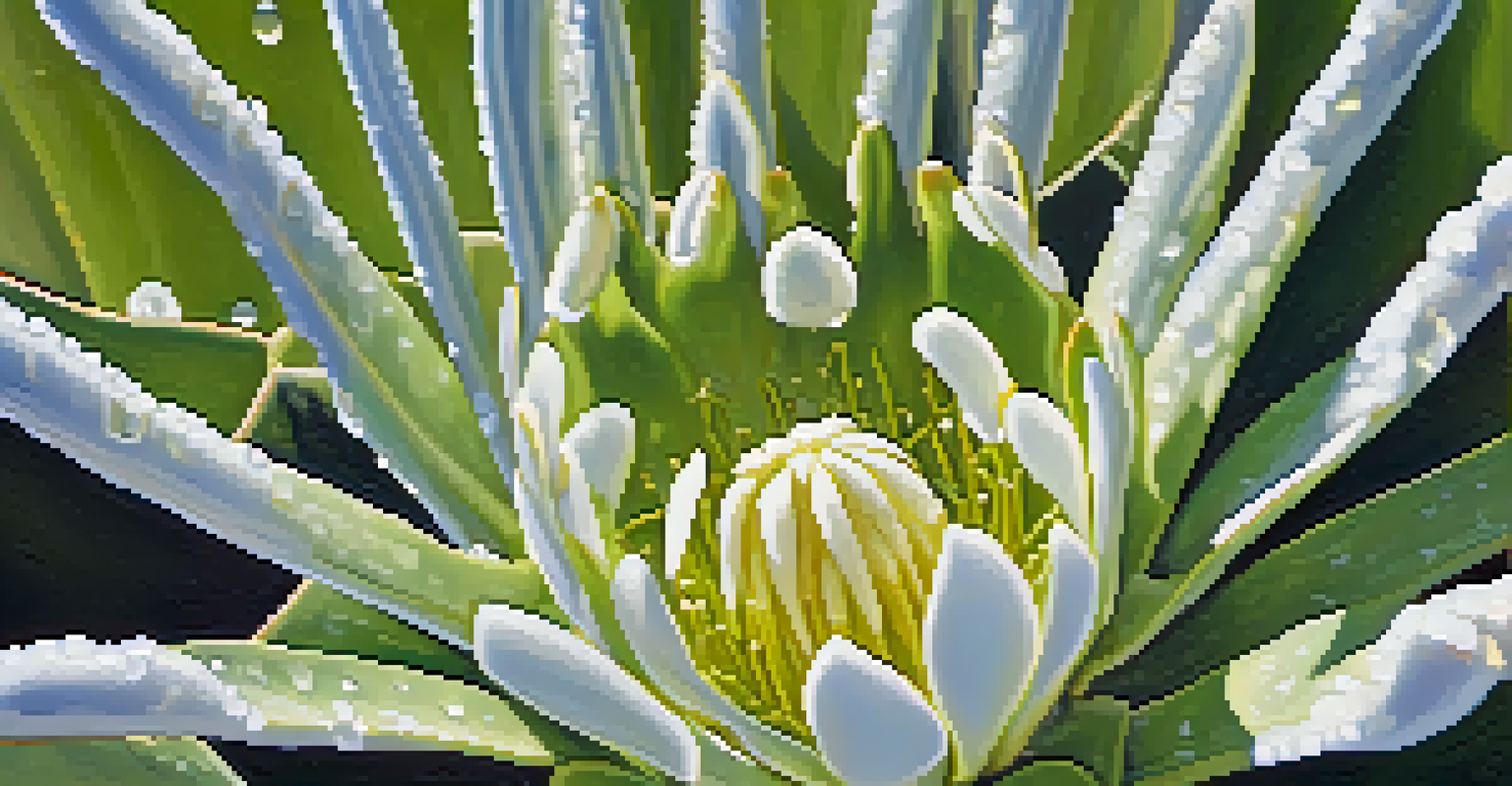Understanding the Ecological Role of Tucson's Cacti Species

Introduction to Tucson's Unique Cacti Ecosystem
Tucson, Arizona, is home to a remarkable array of cacti species, each uniquely adapted to survive in the arid desert landscape. These plants are not just beautiful; they play crucial roles in their ecosystem. Understanding these roles helps us appreciate the delicate balance of desert life.
In the desert, there is no life without water, and cacti are the guardians of this precious resource.
Cacti have evolved over millions of years, developing traits that allow them to thrive in harsh conditions. From the towering saguaro to the smaller, colorful prickly pear, each species contributes to the biodiversity of the region. These plants have adapted to conserve water and withstand extreme temperatures, showcasing nature's ingenuity.
In this article, we will explore the various ecological roles that Tucson's cacti play, emphasizing their importance for wildlife and the environment. By examining their contributions, we can better understand why protecting these unique species is essential.
Cacti as Water Conservation Champions
One of the most fascinating aspects of cacti is their ability to conserve water, a vital resource in the desert. Cacti have specialized tissues that store water, allowing them to survive long periods of drought. This adaptation not only benefits the plants but also plays a significant role in the overall health of the ecosystem.

During heavy rainfall, cacti absorb and store water, creating a reservoir for other plants and animals in the area. This process helps maintain moisture levels in the soil, supporting a variety of life forms that depend on water. In essence, cacti act as nature’s water tanks, providing sustenance in an otherwise harsh environment.
Cacti: Essential for Water Conservation
Cacti act as nature's water tanks, storing vital moisture that supports the desert ecosystem during drought.
By examining their water-conserving strategies, we can learn valuable lessons about sustainability and resource management. Protecting cacti and their habitats ensures the continuation of this essential function in Tucson's desert ecosystem.
Cacti's Role in Supporting Local Wildlife
Tucson's cacti aren't just passive players in the ecosystem; they actively support a wide range of wildlife. Many animals, including birds, insects, and mammals, rely on cacti for food and shelter. For instance, the saguaro cactus provides nesting sites for birds like the Gila woodpecker and offers fruits that many creatures feast on.
Nature does not hurry, yet everything is accomplished.
The flowers of cacti bloom beautifully, attracting pollinators such as bees and butterflies. These pollinators, in turn, help cacti reproduce, creating a symbiotic relationship that sustains both plants and animals. This interconnectedness showcases the vital role cacti play in maintaining biodiversity in the region.
By fostering an environment where wildlife can thrive, cacti contribute to the overall health of the ecosystem. Protecting these plants means safeguarding the myriad of species that depend on them for survival.
Cacti: A Habitat for Various Species
Beyond providing food, cacti create habitats that shelter numerous organisms. The crevices and spines of cacti offer protection for small mammals and reptiles from predators and harsh weather. This makes cacti a crucial component of desert ecosystems, supporting a wide variety of life.
For example, many species of lizards and snakes find refuge among the spines of prickly pear cacti, while small rodents nest in the base of larger cacti. These habitats are essential for the survival of these animals, contributing to the overall biodiversity of the area. Without cacti, many of these species would struggle to find safe places to live.
Wildlife Depend on Cacti for Survival
Cacti provide food and shelter for various wildlife, fostering biodiversity and a balanced ecosystem in Tucson.
The presence of healthy cactus populations directly correlates with the abundance of wildlife in Tucson. By preserving these plants, we ensure that the intricate web of life in the desert continues to flourish.
Cacti and Soil Health: Nature's Builders
Cacti also play a vital role in enhancing soil health. Their roots help stabilize the soil, preventing erosion caused by wind and rain. By anchoring the ground, cacti create a more stable environment for other plants to grow, promoting biodiversity.
Additionally, when cacti drop their leaves and flowers, they contribute organic matter to the soil. This decomposition process enriches the soil with nutrients, fostering a healthier ecosystem. Healthy soil is foundational for plant growth and supports the entire food chain in the desert.
In this way, cacti act as nature's builders, reinforcing the ecosystem around them. By protecting these plants, we are also safeguarding the soil health that supports an array of life in Tucson.
Cacti's Cultural Significance in Tucson
Cacti aren't only ecologically significant; they hold cultural value as well. Indigenous peoples have revered these plants for centuries, utilizing them for food, medicine, and crafts. This deep-rooted connection to cacti highlights their importance beyond just ecological roles.
Many local communities celebrate cacti through art, festivals, and educational programs. By sharing their knowledge and traditions, they foster a greater appreciation for these unique plants and their ecological contributions. This cultural respect encourages conservation efforts and raises awareness about the challenges cacti face.
Cacti Promote Soil Health and Stability
By stabilizing soil and enriching it with organic matter, cacti enhance overall soil health, critical for sustaining desert life.
By understanding and honoring the cultural significance of cacti, we can inspire collective action to protect them. It reminds us that every plant, including cacti, has a story to tell and a role to play in our world.
Conservation Efforts for Tucson's Cacti
As urbanization and climate change threaten Tucson's cacti, conservation efforts have become increasingly vital. Organizations and local communities are working together to protect these species and their habitats. Initiatives include habitat restoration, education programs, and legal protections for endangered species.
Community involvement is crucial in these efforts. By participating in local conservation projects, residents can help protect cacti and promote sustainable practices. Simple actions, like planting native species or reducing water usage, can make a significant difference in preserving Tucson's unique ecosystem.

Through collaboration and education, we can ensure that future generations experience the beauty and ecological importance of Tucson's cacti. By taking steps today, we contribute to a more sustainable future for these remarkable plants.
Conclusion: The Future of Tucson's Cacti Ecosystem
In conclusion, Tucson's cacti are not only iconic symbols of the desert but also vital ecological players. Their roles in water conservation, wildlife support, soil health, and cultural significance underscore their importance in maintaining the region's biodiversity. As we continue to learn about and appreciate these unique species, we must also advocate for their protection.
The future of Tucson's cacti ecosystem depends on our collective efforts to address the challenges they face. By supporting conservation initiatives and fostering a deeper understanding of their ecological roles, we can help ensure that these remarkable plants thrive for generations to come.
Ultimately, protecting Tucson's cacti is about preserving the delicate balance of life in the desert. Together, we can celebrate and safeguard these incredible plants and the ecosystems they support.